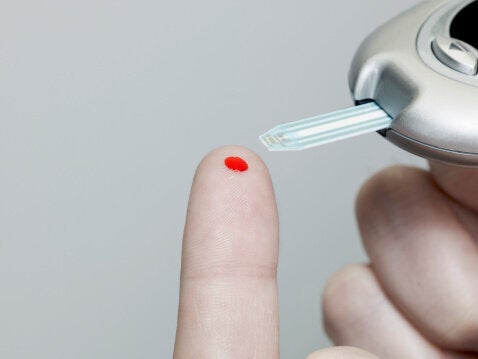Prostate enlargement, also known as benign prostatic hyperplasia, is a common condition that affects older men and while it isn't a serious condition, it can be distressing if you don't know what it is.
Dr Paul Zollinger-Read, chief medical officer for Bupa UK and HuffPost UK blogger says: "Benign prostatic hyperplasia – often referred to as BPH – is a non-cancerous, or benign, enlargement of the prostate gland that can make passing urine difficult. As a man ages, it’s very common for his prostate to become enlarged."

Talking about why this happens, he added: "The prostate goes through two main stints of growth during a lifetime. The first happens in early puberty, when the prostate doubles in size. At around the of age 25, the gland begins to grow again. This is what often causes BPH later on in life.
“As the prostate enlarges, a layer of tissue around it stops it from expanding, which causes the gland to press against your urethra – the tube that connects your bladder to your genitals to remove fluids from your body. Your bladder wall then becomes thicker and irritable, and this makes your bladder contract, even when it contains only a small amounts of urine, causing you to urinate more often. Your bladder eventually weakens and loses the ability to empty itself, so some urine remains in the bladder. It’s the narrowing of your urethra and your bladder only partial emptying that causes many of the symptoms and problems associated with BPH."
Some men don't have symptoms, but for others, BPH has a symptom that is very similar to that of prostate cancer. Emphatically, BPH is not an indicator of cancer at all.
Mr Gordon Muir, consultant urologist at London Bridge Hospital says: "In many men with BPH the prostate swelling causes a narrowing of the passageway from the bladder to the urethra (water pipe.)
"This can cause a slow stream, difficulty emptying the bladder and a a feeling of incomplete emptying. In many men this can be associated with bladder overactivity, which causes frequency of urination, a need to rush to the lavatory and a need to wake at night to pass urine. Urologists will often refer to this as "lower urinary tract symptoms" or LUTS."
In some men, the symptoms are mild and do not require treatment, while in others, symptoms can be very troublesome and have a major impact on their quality of life, says the NHS.
If left untreated (maybe because you're too scared to see your doctor, Mr Muir advises that it can lead to incontinence, urinary infections, and retention of urine can occur. "This can, in extreme cases, mean emergency admission to hospital and even irreversible kidney failure."
While there is no cure, in many cases, little to no treatment is needed.
Dr Zollinger-Read says: "“If you have mild BPH, there are certain things you can do to help yourself. Keep alcohol, caffeine, artificial sweeteners and fizzy drinks to a minimum, and be sure to empty your bladder when you get the urge.
"BPH has been related to obesity, therefore, eat well and exercise regularly to help maintain a healthy weight. If you’re overweight, try to lose any excess you carry as it may improve any symptoms.”
Medicine can be taken for it, under advisement from your GP.
Mr Muir expands: "Drug therapy can be with medicine to relax the prostate (alpha blockers) or medication to shrink the prostate (drugs such as Avodart or Proscar.) These medications can reduce the chance of men needing surgery or developing complications of BPH."
Men who do not respond to medical treatment, or who have side effects, can in almost all cases be very successfully treated by surgery.
"The traditional operation of TURP," he adds, "gives excellent results but at the cost of several days in hospital and a significant risk of sexual side effects, but was often felt unsafe for very large prostates or patients with co-morbidities which limited their options.
"Modern laser surgery means that all men can be offered minimally invasive treatment either as a day case or with a short hospital stay, and a dramatic improvement in their symptoms. Nowadays the risks of severe bleeding, incontinence or impotence are very low.
"Another new option is the Urolift procedure which involves placing stitches into the prostate to open the channel. This revolutionary new technique has the dual advantage of being performed as an outpatient under local anaesthesia, and having NO reported sexual side effects."
Sources:
- Benign prostatic hyperplasia. The Merck Manuals. http://www.merckmanuals.com/home/mens_health_issues/benign_prostate_disorders/benign_prostatic_hyperplasia_bph.html, published June 2013
- Prostate Enlargement: Benign Prostatic Hyperplasia. National Kidney and Urologic Diseases Information Clearinghouse (NKUDIC). http://kidney.niddk.nih.gov/kudiseases/pubs/prostateenlargement/, published March 2012
- Prostate Enlargement: Benign Prostatic Hyperplasia. National Kidney and Urologic Diseases Information Clearinghouse (NKUDIC). http://kidney.niddk.nih.gov/kudiseases/pubs/prostateenlargement/, published March 2012
- Prostate Enlargement: Benign Prostatic Hyperplasia. National Kidney and Urologic Diseases Information Clearinghouse (NKUDIC). http://kidney.niddk.nih.gov/kudiseases/pubs/prostateenlargement/, published March 2012
- Prostate Enlargement: Benign Prostatic Hyperplasia. National Kidney and Urologic Diseases Information Clearinghouse (NKUDIC). http://kidney.niddk.nih.gov/kudiseases/pubs/prostateenlargement/, published March 2012
- Benign Prostatic Hyperplasia. PatientPlus. http://www.patient.co.uk/doctor/benign-prostatic-hyperplasia, published October 2012
- Prostate Enlargement: Benign Prostatic Hyperplasia. National Kidney and Urologic Diseases Information Clearinghouse (NKUDIC). http://kidney.niddk.nih.gov/kudiseases/pubs/prostateenlargement/, published March 2012
- Benign prostatic hyperplasia. The Merck Manuals. http://www.merckmanuals.com/home/mens_health_issues/benign_prostate_disorders/benign_prostatic_hyperplasia_bph.html, published June 2013
- Benign prostatic hyperplasia. The Merck Manuals. http://www.merckmanuals.com/home/mens_health_issues/benign_prostate_disorders/benign_prostatic_hyperplasia_bph.html, published June 2013
- Prostate Enlargement: Benign Prostatic Hyperplasia. National Kidney and Urologic Diseases Information Clearinghouse (NKUDIC). http://kidney.niddk.nih.gov/kudiseases/pubs/prostateenlargement/, published March 2012
